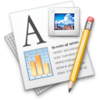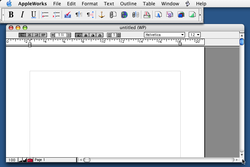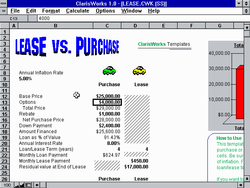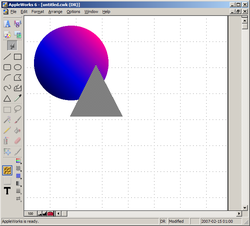- AppleWorks
-
AppleWorks 

AppleWorks 6 for Mac OS X.Developer(s) Apple Inc. Initial release 1984 Stable release 6.2.9 (Mac OS X)/6.2.8 (Mac OS 8.1-9.2.2)/6.2.2 (Windows) / 14 January 2004 Development status End-of-Life / EOL (August 15, 2007) Operating system Mac OS X, Mac OS, Windows 2000 or later Type Office Suite License Proprietary Website Appleworks Support AppleWorks refers to two different office suite products, both of which are now discontinued. Originally, AppleWorks was an integrated software package for the Apple II platform, released in 1984 by Apple Computer. In 1998, the name AppleWorks was repurposed by Apple following its elimination of its Claris subsidiary, which marketed a software package for Macintosh and Windows named ClarisWorks. At one time, AppleWorks was bundled with all consumer-level Macs sold by Apple.
As of August 15, 2007, AppleWorks has reached end-of-life status, and is no longer being sold.[1] Word processing, spreadsheet, and presentation applications with capabilities similar to AppleWorks are currently sold as the iWork suite.
Contents
"AppleWorks Classic" (Apple II version, 1984–1991)
The original AppleWorks was one of the first integrated office suites for personal computers, featuring a word processor, spreadsheet, and database merged into a single program. It was written by Bob Lissner and released in 1984 by Apple for the Apple II family of computers. Apple had previously published Lissner's QuickFile, a database program that closely resembled what became the AppleWorks database module. An Apple III version of AppleWorks, which used the same file formats, was dubbed III E-Z Pieces and marketed by Haba Systems.
Wary of stepping on the toes of its third-party developers, including its own popular AppleWriter word processing application, Apple barely promoted the product at all. AppleWorks nevertheless debuted at #2 on the Softalk's monthly bestseller list and quickly became the best-selling software package on any computer, ousting even Lotus 1-2-3 from the top of the industry-wide sales charts[2]
Apple released version 2.0 in 1986, and then a year later the program was published by Apple's new software subsidiary Claris. Claris contracted with Beagle Bros to upgrade AppleWorks to version 3.0 in 1989, then turned its attention to producing Macintosh and Windows software, letting AppleWorks languish. Claris did, however, finally agree to license the AppleWorks trademark to Quality Computers, which released AppleWorks 4.0 in 1993 and AppleWorks 5.0 in 1994.
In the mid 1980s, many companies provided "add ons" to AppleWorks. One of the most successful was the TimeOut series from Beagle Bros. TimeOut developers Alan Bird, Randy Brandt and Rob Renstrom were involved in developing AppleWorks 3.0 and eventually AppleWorks incorporated numerous TimeOut functions. [1]. TimeOut developers Randy Brandt and Dan Verkade created AppleWorks 4.0 and 5.0 for Quality Computers.
The 8-bit AppleWorks is sometimes referred to as "AppleWorks Classic" in order to differentiate it from AppleWorks GS as well as the later product for Macintosh and Windows of the same name.[citation needed] The term "Classic" in this context does not refer to the Classic compatibility environment in Mac OS X.
Versions of "AppleWorks Classic"
Version Year Notes 1.0 1984 First release. 1.1 1985 Fixed hardware bugs with printers and interface cards. 1.2 1985 More hardware compatibility improvement. 1.3 1986 Hardware support enhancements. Update cost $20. 2.0 September 1986 More features and better hardware support. Update cost $50. 2.1 September 1988 Bug fixes and hardware compatibility improvement. Released by Claris. 3.0 1989 More features. Update either cost $79 or $99. 4.0 1 November, 1993 More features. Released by Quality Computing. 4.01 Early November, 1993 Bug fixes. 4.02 Bug fixes. 4.3 1993 [2] 5.0 November 1994 Code-named 'Narnia'. 5.1 Summer 1995 Bug fixes. AppleWorks GS (Apple IIgs version, 1988–1996)
In 1988, Claris acquired an integrated package called GS Works from StyleWare and renamed it AppleWorks GS, bringing the AppleWorks brand to the 16-bit Apple IIgs, though no code from the 8-bit Apple II version was used. In addition to the word processing, database, and spreadsheet functions, AppleWorks GS also included telecommunications, page layout and graphics modules. Only one version of major AppleWorks GS was ever published, progressing as far as 1.1, although a vaporware 2.0 update was rumored to be "just short of completion" for a long time. [3]
Versions of AppleWorks GS
Version Year Notes 1.0 1988 First version 1.0v2 Bug fix release. 1.1 1989 Supports System Software 5. 1.2 (not released) Planned bug fix release, developed by Quality Computers. 2.0 (not released) Planned release, developed by Quality Computers. AppleWorks/ClarisWorks (Macintosh/Windows versions, 1991–2004)
The modern incarnation of AppleWorks started life as ClarisWorks, written by Bob Hearn and Scott Holdaway and published by Claris (a spin-off from Apple, today known as FileMaker Inc).[citation needed] The file extension of AppleWorks and ClarisWorks documents is .cwk.[citation needed] ClarisWorks combined[citation needed]
- a word processor,
- a drawing program,
- a painting program,
- a spreadsheet,
- a database program,
- and a terminal program for communications.
- Also, a GUI based equation editor bundled.
All the components were integrated to provide a seamless suite that worked in concert; for example, spreadsheet frames could be embedded in a word processing document, or formatted text into drawings, etc. A common misconception[citation needed] is that the components were derived from the existing Claris programs MacWrite and MacDraw. In fact, ClarisWorks was written from scratch and then redesigned to match other Claris programs after the purchase by Claris.[citation needed]
ClarisWorks 1.0 shipped for the Macintosh in 1991 and subsequently ported to the Windows platform, shipping as ClarisWorks 1.0 for Windows in 1993.[citation needed] When the Claris company was disbanded and absorbed back into Apple, the product was renamed AppleWorks; in fact, version 5 of the software was first briefly called ClarisWorks 5, before being renamed AppleWorks 5 following the product's return to Apple.
The last version, AppleWorks 6, replaced the communications feature with a presentation feature (in prior versions there was only rudimentary support for presentations through the other features).[citation needed] It was also ported to the Carbon API to work on Mac OS X, but as an early Carbon application, it did not take advantage of many of the newer features of Mac OS X and portions of the interface still retained elements of the Platinum appearance of Mac OS 8/9.
Using Claris' XTND framework, AppleWorks could create, open, and save files in a number of file formats. For example, word processor documents could be saved in Microsoft Word format, and spreadsheet files could be saved in Microsoft Excel format.
The software received good reviews[citation needed] during the course of its lifespan for its interface and the tight integration of its modules. For example, like the earlier versions mentioned above, in AppleWorks a drawing "frame" could be placed in a spreadsheet document, a paint frame could be placed in a drawing document, etc. This allowed for very elaborate and data-rich layouts. However, the limitations of the product (such as its confusing and cumbersome stylesheet feature) became more apparent as the product aged. The program also only allowed for a single undo/redo, and in many cases, if a frame from one module was placed in another module, the frame would no longer be editable in any way as soon as it was deselected.[citation needed] In August, 2007, Apple declared AppleWorks "end of life" and stated that they will no longer sell the package. The iWork package, which includes a word processing program, a spreadsheet, and a presentation graphics program, is intended to be its replacement. While much more feature-rich, iWork still lacks some of the modules and the tight integration of AppleWorks.[citation needed] AppleWorks will not run on any versions of Mac OS X later than Snow Leopard because it is written in PowerPC code.
Equation Editor by Design Science was bundled with AppleWorks. Also, the MathType or MathMagic equation editors can be used. Both support automatic baseline alignment for inline equations.
 The paint module, with integrated text and spreadsheet modules.
The paint module, with integrated text and spreadsheet modules.
 The database module.
The database module.
 The spreadsheet module.
The spreadsheet module.
Competing software
- Alpha Five
- Borland Paradox
- DataEase
- dBase
- FileMaker Pro (formerly Claris FileMaker)
- Verside.org
- Kexi
- LibreOffice
- Lotus Approach
- Microsoft Office
- NeoOffice
- OpenOffice.org Base
- Sun StarBase
- Symantec GreatWorks
- FoxPro (later acquired by Microsoft)
- SQLite
- Sybase PowerBuilder
- nuBuilder
- Omnis Studio
See also
- iWork
- List of office suites
- Comparison of office suites
- AppleWorks User Group
- Formula editor or MathMagic WYSIWYG equation editor
References
- ^ Evans, Jonny (15 August 2007). "Apple cans AppleWorks". Macworld UK. http://www.macworld.co.uk/macsoftware/news/index.cfm?RSS&NewsID=18827. Retrieved 2007-08-15.
- ^ Apple II History Appleworks page: Apple's "Promotion" of Appleworks (Retrieved on 13 June 2009)
External links
- Apple: iWork
- A Brief History of ClarisWorks - A history of ClarisWorks/AppleWorks from one of the original developers, Bob Hearn.
- Apple II History: AppleWorks - Chapter of an Apple II History dedicated to AppleWorks.
- GUIdebook > Articles > "Apple II User Interfaces"
- AppleWorks at VersionTracker
- ArsTechnica: RIP Appleworks
Apple Inc. software OS Darwin · Mac OS X (Public Beta · "Cheetah" · "Puma" · "Jaguar" · "Panther" · "Tiger" · "Leopard" · "Snow Leopard" · "Lion") · iOS (version history)Consumer Prosumer Professional Aperture · FileMaker Pro · Final Cut Studio (Final Cut Pro · DVD Studio Pro · Motion · Soundtrack Pro · Color · Compressor) · Logic Studio (Logic Pro · Mainstage · Soundtrack Pro)Bundled Front Row · iChat · iTunes (version history) · Mail · Photo Booth · QuickTime · Safari (version history) · TextEditServer Developer Discontinued .Mac · AppleWorks · HyperCard · Final Cut Express · Mac OS (System 6, 7 · Mac OS 8, 9) · MacDraw · MacPaint · MacProject · MacTerminal · MacWrite · ResEdit · ShakeOffice suites Desktop suites Open source Freeware IBM Lotus Symphony · SoftMaker Office (2008)Retail Discontinued 
Online suites Open source Proprietary Related technologies Category • Comparison • List (Spreadsheet software • Vector graphics editor • Word processors) Apple Inc. software on Windows platforms AirPort Utility · AppleWorks · Bonjour · Boot Camp · iTunes · MobileMe · QuickTime · Safari · Software UpdateCategories:- Apple Inc. software
- Office suites
- Apple II software
- Mac OS software
- Mac OS X software
- Windows software
- Discontinued software
- Apple II word processors
- 1984 software
- 1998 software
Wikimedia Foundation. 2010.




